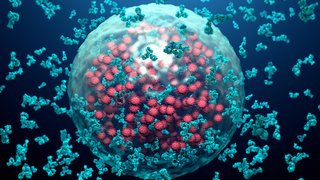Causes of Blood Disorders
Some blood disorders are inherited, meaning they are caused by a gene mutation and present at birth. Some people acquire, or develop, blood disorders due to infections, other medical conditions, medication side effects, or nutrition deficiency. In some cases, the cause is unknown.
For example, the most common type of anemia is caused by low iron levels. Some types of anemia are inherited while others are caused by chronic disease, such as kidney disease. Most of the time, hemophilia is inherited, but some people acquire it. Acquired hemophilia is associated with pregnancy, autoimmune conditions, cancer, multiple sclerosis, and reactions to drugs. Occasionally, the cause is unknown.
Paroxysmal nocturnal hemoglobinuria (PNH) is an example of an acquired blood disorder. It’s caused by an acquired mutation of the PIGA gene, which affects bone marrow stem cells involved in blood cell production. The disorder might occur due to weakness or failure of the bone marrow.
Acquired pure red cell aplasia (PRCA) is also connected to bone marrow failure. PRCA may occur due to an autoimmune disorder, a thymus gland tumor, a viral infection, certain blood cancers, or use of certain medications. In some cases, the cause is unknown.
Symptoms of Blood Disorders
Symptoms vary depending on the type of blood disorder and what part of the blood is affected.
Symptoms of blood disorders affecting the red blood cells include:
- Feeling fatigued, weak, or cold
- Shortness of breath
- Headache
Symptoms of blood disorders affecting the white blood cells include:
- Fever
- Frequently developing infections
Symptoms of bleeding (platelet) disorders include:
- Continuous bleeding or bruising after an injury, surgery, dental care, or a shot, such as a vaccination
- Easy bruising
- Blood clots
- Frequent nose bleeds
- Heavy menstrual bleeding
- Skin rash
Diagnosing Blood Disorders
At UT Southwestern, our doctors check for blood disorders by examining the patient, reviewing the patient’s medical history, and ordering blood tests, such as a complete blood count (CBC), to check for blood disorders. A CBC measures blood components, including red blood cells, white blood cells, hemoglobin, and platelets.
Tests are available to check for specific conditions, including hemophilia, von Willebrand disease, polycythemia vera, and paroxysmal nocturnal hemoglobinuria (PNH).
If hemophilia is suspected, our providers might recommend a blood test to measure how much clotting factor is in the blood and how long it takes the blood to clot. We use this information to diagnose the type of hemophilia and to classify the disorder as mild, moderate, or severe.
If PNH is suspected, our providers might recommend a blood test called flow cytometry. This test looks for PNH cells, which are blood cells lacking a crucial protein.
In certain cases, we might recommend a bone marrow biopsy to assist with diagnosis.
For some blood disorders, such as sickle cell disease and severe hemophilia, early diagnosis is essential in providing proper preventive treatment for complications.
Our pediatric hematologists perform a careful evaluation of each child – including providing biopsies in collaboration with our UT Southwestern partners in Dallas when necessary and when there is a concern for cancer. Once we have a diagnosis, we use the latest therapies to provide specialized, compassionate care.
Blood Disorders Treatment
With treatment, some blood disorders resolve. Chronic blood disorders may be managed but persist throughout the patient’s life.
The range of treatments for blood disorders includes:








